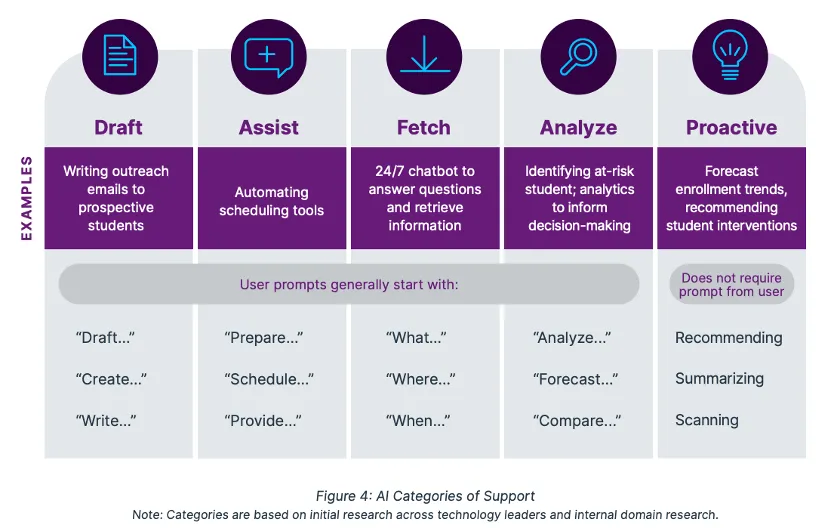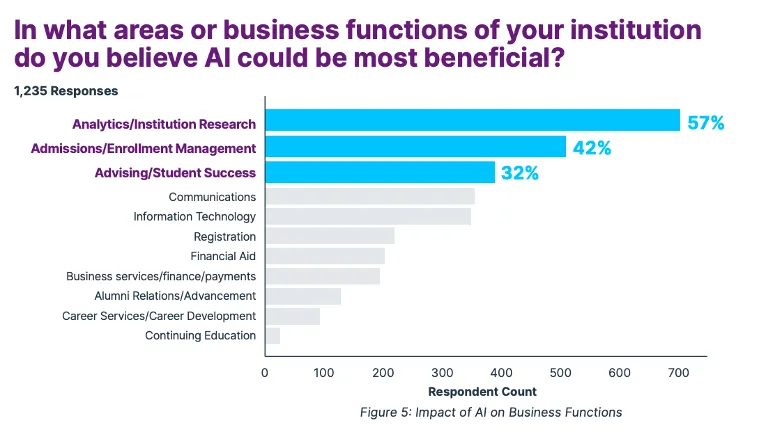In the rapidly evolving postsecondary landscape, institutions and their leaders face multifaceted challenges such as the need to modernize solutions, to transform business practices to achieve equitable attainment. Adapting to these challenges requires transformative solutions, and one powerful tool that may help leaders address these issues is Artificial Intelligence (AI).
AI is a collection of technologies designed to enable systems to mimic human cognitive functions, while Machine Learning (ML), a subset of AI, allows systems to learn and improve from experience. Although not new, recent advancements, exemplified by programs like ChatGPT, have thrust AI and Machine Learning into the spotlight. While there is immense potential, responsible implementation is key, differentiating institutions and paving the way for meaningful change.
There have been significant, early efforts in AI and ML unfolded at colleges and universities. It has been used to unlock scientific breakthroughs and drastically accelerate learning—the perceived newness of them in the public has brought a strong reaction.
Use of AI in higher education administration is still an emerging area for institutional strategies and practices. In fact, according to a recent Ellucian-conducted survey of more than 1,000 higher education administrators regarding how they use AI, 48% of respondents reported that they had not yet used AI in their personal or professional lives at all. Out of those who do use AI, most reported using it for simple data retrieval rather than the more advanced analytical and predictive capabilities AI can offer. Regardless of your institution’s reaction, its capacity to responsibly embrace this emerging and rapidly evolving technology is what will differentiate your institution from others.
Technologists are rushing to find the next big use case, and campus leaders are asking their leaders how AI can help them meet their goals. Harnessing the potential of AI will require efforts from all sectors of an institution. Leaders, including staff under the CIO office, provost, student success leaders, and CFO, must equip themselves with the knowledge to engage in conversations on this topic.
Getting started with AI
In a response to a question about AI posted on Ellucian’s EllumiNation page, Esteban Burbano, Process Analyst Registrar Office at Universidad San Francisco de Quito said “Artificial intelligence can help improve service and decision-making within our area. It can also help us carry out institutional research to create panels with indicators to improve decision-making. Likewise, it can help us automate repetitive processes.”
One way to utilize AI in higher education is to think of it like a platform of services focused on assistance that is always ready, willing, and able to support your staff by performing tasks that are time- or labor-intensive or require dynamic analysis that would take valuable resources and time if done solely by humans. Looking at the following five categories of AI usage can help get you started on building your AI services platform.

These categories can each represent a digital assistant: Respectively, they could represent a ghost writer for drafting copy, a personal assistant for scheduling items and meetings for you, a research assistant to fetch data quickly, a data analyst to make sense of large swaths of data, and a trend forecaster for keeping an eye on in-need students and predicting trends in enrollment.
Characteristics of Emerging AI Use Cases in Higher Education
Some emerging practices in AI-based acceleration are around the most cumbersome tasks that can be automated without removing human oversight entirely. Some common traits include:
- Tasks that are manual and labor-intensive: These are usually prone to error.
- Tasks that require a high level of analysis: Supporting tasks that require significant manpower to synthesize—usually for systems that have a large amount of data to sift through.
- Tasks that require complex pattern recognition: AI can be set to find correlations in data that may be missed otherwise.
- Tasks with constraints that AI can unlock: These are tasks that are impeded currently because of operational constraints.
- Tasks where you have the best source of data to train the AI: AI and ML depend on data as brain food. The more quality data with which you can fuel them, the more you can do with AI and ML.
Some in the sector, such as post secondary educational consultants, believe that artificial intelligence can help optimize various operational aspects at all levels. A report from World Economic Forum estimates that 20-30% of faculty members’ time performing routine administrative tasks could be reallocated towards student learning-based activities. Furthermore, this task delegation potentially reduces operational costs, helps the student body thrive, and enhances overall academic success for students.
In a resulting report based on Ellucian’s AI survey, authored by Ellucian’s Karla Beltran, administrators said that the three areas with the most potential for artificial intelligence integration are institutional research and analytics, admissions, and advising.

With institutional research and analytics, AI can dynamically analyze campus data on classroom utilization, faculty availability, and more, and then use it to generate optimal class schedules that minimize conflicts and evenly distribute teaching loads. For admissions, AI chatbots can engage with students in real time to answer their questions and streamline the application and financial aid processes while building valuable reports for leaders about enrollment trends. Properly-implemented AI can help advisers recommend courses for students and identify resources that those students may need in order to thrive on their academic journey.
How to start this conversation with your leadership
An AI-enabled technology working for you has the potential to elevate your and your team's work to the next level. U.S. President Joseph R. Biden, Jr.’s Executive Order on Safe, Secure, and Trustworthy Artificial Intelligence, issued on October 30, 2023, specifically mentions President Biden’s direction to “Shape AI’s potential to transform education by creating resources to support educators deploying AI-enabled educational tools.” Additionally, AI’s implications to the education sector are more than learning tools for educators and students, but also operational tools for staff and administrators. Without nuances and open conversations with your team, it can be a nerve-racking experience for your human staff. In many fields, not just postsecondary education, the nature of work is expected to change—and in some cases jobs are expected to be replaced by AI and AI-powered tools. Implementation of these new technologies must be paired with thoughtful strategies for reskilling and upskilling of your campus workforce, ensuring that human oversight is integrated into the deployment and management of these tools.
Despite the interest in AI, higher education has only begun to scratch the surface of its potential. Read the full report detailing Ellucian's AI findings.







